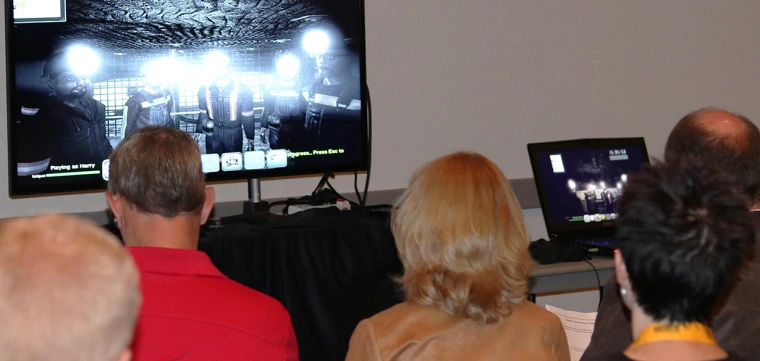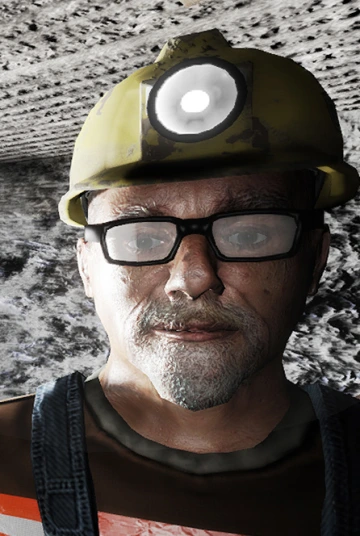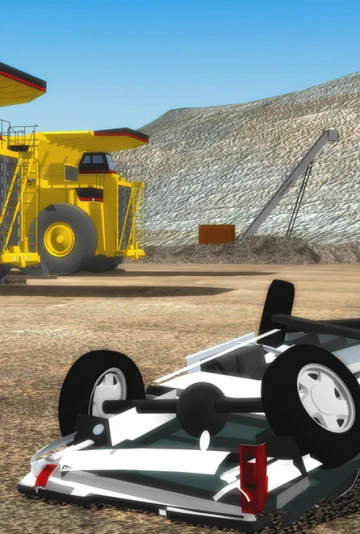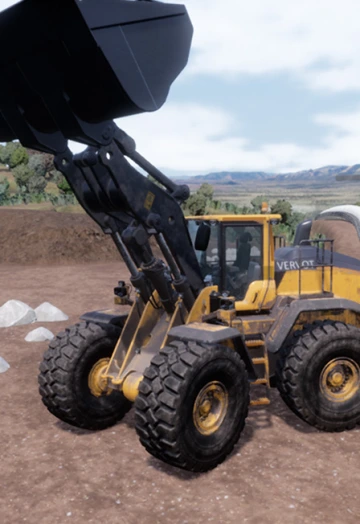
Background
Research suggests that experiential "learn by doing" activities, such as those afforded by serious games, can enable knowledge retention rates as high as 90%; contrast this with passive learning methods, such as lectures and slideshows, which have transfer rates of under 30%.[1] Computer-based serious games are a particularly powerful form of active learning that involves using video games for educational purposes; they are "the application of game technology, process, and design to the solution of problems faced by businesses and other organizations." [2] In the real world, video games provide one of the few truly 3D learning constructs available to the classroom teacher.[3] Furthermore, games compel users to participate in, and contribute to, the learning process.[4]
Learn with Harry™ is a suite of advanced serious games called Synthetic Learning Environments (SLEs). SLEs combine games, simulations, and analytics in a way that caters to the motivations of the individual learner.[5][6] By managing the user’s experience in the virtual world, SLEs create an optimal context for learning.[6] Learn with Harry teaches mine safety competency by using challenging game activities embedded in a reality-based virtual world that is customizable to the learner's level of competency and capability. The software supports multiple computing platforms, including PCs, Virtual Reality headsets, tablets, and mobile devices.
This evolving project has three learning environments, each covering numerous MSHA training topics in an engaging story:
- Harry's Hard Choices: A story of mine disaster and survival through efficient self-escape
- Harry's Fatalgram Simulator: Reconstructions of MSHA fatality reports and best practices
- Harry's Hazardous Day: A high-pressure production environment where everything goes wrong
For more information, please see our Learn With Harry Flyer (PDF).
Harry's Hard Choices is a training tool for mine emergency response that is based on the eponymous NIOSH paper exercise.[7] The game is story-driven and designed as a team-oriented, single player experience. The learner must role-play as a section foreman tasked with leading a team of miners (non-players) to safety during an underground coal mine disaster featuring many tough choices. The game places users in a visually and audibly rich virtual environment that mimics the distractions and chaos of a realistic mine emergency. Users experience the game from a first-person perspective, with freedom of choice to go anywhere and interact with many objects and characters in the virtual world. Each choice and action has situational consequences that can vastly impact the outcome, including survival of the crew. The game tests players’ decision-making in response to various disaster events, including fires, smoke, limited visibility, irrespirable gases, leg injuries, broken equipment, and bad ground controls. As in a real emergency, crew resource management, situational awareness, and time management are key skills needed for positive outcomes.
Harry's Hard Choices was the Center's first complete serious game. It has been thoroughly vetted through multiple levels of usability assessment with over 120 miners; testing indicated a high degree of user engagement and a very high willingness to play. Although the game features an emergency scenario, its emphasis on problem solving around hazards recognition, communication, and other key topics required for New Miner and Annual Refresher make it a popular application to use in many training settings. To date, well over 1,000 miners have been trained with Harry's Hard Choices. Funding for this initiative was provided in part by MSHA through the Brookwood-Sago Mine Safety Grants Program. A detailed discussion of the game design and usability assessments may be found in Brown (2015).[8] Additional images and videos can be found in the visual showcase.
Quick Facts: Harry's Hard Choices
| Media Type | Computer-Based Serious Game |
| Primary Authors | Leonard Brown, Michael Peltier, Ros Hill, Mary Poulton |
| Training Topics | Communications, Emergency Response, Hazards Recognition, Leadership & Decision-Making, Self-Escape, Mine Gases, Miner Health |
| Primary Sectors | Coal (Underground), Metal / Non-Metal (Underground) |
| Number of Players | 1 player |
| Activity Time | 40-60 minutes |
| Requirements | Microsoft Windows 7+ Intel i5 7th Gen (Kaby Lake) CPU, NVidia GT 1050 Ti 4GB Graphics, 16 GB Main Memory (RAM), Microsoft Xbox One Controller |
| Train-the-Trainer? | Available (Recommended) |
| VR Support? | No |
| Tablet Support? | Windows (x86) |
| Customizable? | No |
| Downloads | Datasheet, 2 pages (PDF), White Paper, 32 pages (PDF), Game Script, 76 pages (PDF), Game Tutorial, 18 pages (PDF), Trainer Manual, 32 pages (PDF) |
| Expansion Packs | No |
Harry's Fatalgram Simulator
Motivated by the requirements of annual refresher training, we have developed an interactive game to teach MSHA fatality reports and best practices. Harry's Fatalgram Simulator features a series of ten minute mini-games, that allow users to observe circumstances of fatality events and then dive into those stories to change outcomes. Harry's Fatalgram Simulator was designed to illustrate the complicated sequences of events that often contribute to fatalities, including communications breakdowns, distractions, and blind spots. Scenarios can be designed for this synthetic learning environment to address all major sectors of the mining industry — including Coal, Metal / Non-Metal, and Aggregates. Although originally intended to simulate MSHA fatality reports, Harry's Fatalgram Simulator can also to repurposed to simulate non-fatal accidents and near misses and is easily customized for specific mine sites and mine methods. Furthermore, it is our first game to incorporate full multi-player capabilities, allowing teams of users on the same crew to interact within a virtual environment, collaboratively solving safety problems.
Harry's Fatalgram Simulator also offers a much greater level of presentation flexibility to examine all aspects of a fatality scene than is possible with traditional classroom media. In our field studies, we often noted confusion or misunderstandings of spatial relationships among learners, particularly when the learner's view was incomplete. Furthermore, a survey of fatality reports suggests that visibility constraints play a major factor in many accidents. In Harry's Fatalgram Simulator, the accident scene can be carefully reconstructed as a 3D virtual environment that users can explore the accident from different angles. Numerous viewing modes allow the trainer or student to see through the eyes of an actor, observe a cinematic sequence, or float freely around the scene as a bird. Additional images and videos of Harry's Fatalgram Simulator may be found in the visual showcase.
Quick Facts: Harry's Fatalgram Simulator
| Media Type | Computer-Based Serious Game (Synthetic Learning Environment) |
| Primary Authors | Leonard Brown, Michael Peltier, Ros Hill, Mary Poulton |
| Training Topics | Hierarchy of Controls, Fatality Reports, Prevention of Accidents |
| Primary Sectors | All Sectors |
| Number of Players | 1-3 players |
| Activity Time | 10-15 minutes per fatalgram |
| Requirements | Microsoft Windows 7+ Intel i5 7th Gen (Kaby Lake) CPU, NVidia GT 1050 Ti 4GB Graphics, 16 GB Main Memory (RAM), Microsoft Xbox One Controller |
| Train-the-Trainer? | Available (Recommended) |
| VR Support? | Yes |
| Tablet Support? | Future Work |
| Customizable? | Yes |
| Downloads | Datasheet, 2 pages (PDF), White Paper, 12 pages (PDF), Trainer Manual, 20 pages (Coming Soon) |
| Expansion Packs | Future Work |
Harry's Hazardous Day
Our most recent development, Harry's Hazardous Day focuses on accident prevention through situational awareness, hazards recognition, and adherence to standard operating procedures (SOPs). Designed around MSHA's Rules to Live By, the game features a story-driven scenario that starts with pre-shift inspection and progresses through normal shift activities as new hazards are introduced into the worksite. This is our first SLE to feature a persistent and perpetual virtual world — a world that continues to evolve even after players quit the game. Time is simulated, allowing for multiple shifts and an ongoing cycle of weather and aging. Character advancement, through rewards and penalties, also features prominently. The game supports user-specific, custom avatars that may be advanced through skills development and achievements. Learners will be able to role-play their characters in specialized job roles that include haul truck drivers, loader operators, maintenance workers, and crusher operators. Furthermore, a modular scenario structure enables trainers to select content based on the training objective, ranging from short modules on inspection techniques to full-cycle, multi-user production scenarios.
The first scenario for Harry's Hazardous Day, "The Big Pour" places learners in a multiplayer scenario in which they must meet production quotas under stressful time constraints. Learners must perform workplace examinations and respond to hazardous situations involving equipment breakdowns and an unscheduled work stoppage. The scenario is set in an aggregates quarry and features a prototypical crusher facility, conveyors, and operating haulage, as well as a functional quarry with high walls, berms, and access roads. Hazards have been chosen based on deficiency trends identified during testing with new and experienced miners.[9] Furthermore, the game allows mitigation of hazards with options that include reporting, guarding, correcting, and suspending work. Learners must select mitigation strategies based on risks to health and safety and against time and resource constraints; the mitigation strategy will impact the types of consequences realized in the game and production outcomes. An active development, Harry's Hazardous Day: "The Big Pour" is now alpha testing with select industry partners. Additional images and videos are available in the Harry's Hazardous Day visual showcase.
Quick Facts: Harry's Hazardous Day
| Media Type | Computer-Based Serious Game (Synthetic Learning Environment) |
| Primary Authors | Michael Peltier, Leonard Brown, Mary Poulton |
| Training Topics | Communications, Hazards Recognition, Hazards Mitigation, Hierarchy of Controls, Miner Health, Situational Awareness, Worker Rights & Responsibilities, Workplace Examinations |
| Primary Sectors | Metal / Non-Metal (Surface), Stone, Sand, Gravel |
| Number of Players | 3-10 players |
| Activity Time | Use-case specific: 15+ minutes; Persistent virtual world, Save & resume session |
| Requirements | Microsoft Windows 7+ Intel i5 7th Gen (Kaby Lake) CPU, NVidia GT 1050 Ti 4GB Graphics, 16 GB Main Memory (RAM), Microsoft Xbox One Controller |
| Train-the-Trainer? | Available (Recommended) |
| VR Support? | Yes |
| Tablet Support? | Future Work |
| Customizable? | Yes |
| Downloads | Datasheet, 2 pages (PDF), White Paper, 30 pages (PDF), Game Mechanics, 23 pages (PDF), Trainer Manual, 30 pages (Coming Soon) |
| Expansion Packs | The Big Pour (Coming Soon) |
- Dale E. (1969). "Cone of Experience." In Wiman, R.V. & Meierhenry, W.C. (Eds), Educational Media: Theory into Practice. Columbus, OH: Charles Merrill. ISBN: 978-0675095525
- Susi, T., Johannesson, M., & Backlund, P. (2007) “Serious Games – An Overview,” Technical Report HS-IKI-TR-07-001, Univ. of Skövde. Available at https://www.diva-portal.org/smash/get/diva2:2416/FULLTEXT01.pdf.
- DeKanter, N. (2005). "Gaming Redefines Interactivity for Learning," TechTrends: Linking Research & Practice to Improve Learning, v. 49(3), pp. 26-31. https://doi.org/10.1007/BF02763644
- Gee, J.P. (2004). Situated Language and Learning: A Critique of Traditional Schooling London: Routledge. ISBN: 978-0415317764
- Dede, C., Salzman, M. C., Loftin, R. B., & Sprague, D. (1999). "Multisensory Immersion as a Modeling Environment for Learning Complex Scientific Concepts." In Feurzeig, W. (Eds.) Modeling and Simulation in Science and Mathematics Education. New York, NY: Springer, pp. 282-319. ISBN: 978-1461214144
- Cannon-Bowers, J., & Bowers, C. (2009). "Synthetic Learning Environments: On Developing a Science of Simulation, Games, and Virtual Worlds for Training." In Kozlowski, S. & Salas, E. (Eds.), Learning, Training, and Development in Organizations. London: Routledge, pp. 250-282. ISBN: 978-0415649674
- Vaught, C., Hall, E.E., & Klein, K.A. (2009). "Mining Product: Harry's Hard Choices: Mine Refuge Chamber Training." National Institute for Occupational Safety and Health (NIOSH), Centers for Disease Control and Prevention (CDC), Dept. of Health and Human Services, U.S. Publication 2009-122 Information Circular 9511. Available at NIOSH / CDC
- Brown, L. D. (2015). Design, Evaluation, and Extension of Serious Games for Training in Mine Safety. Ph.D. Dissertation, Dept. of Computer Science, Univ. of Arizona, Tucson, AZ. Available at Univ. of Arizona Libraries
- Eiter, B., et al. (2017). "Recognizing Mine Site Hazards: Identifying Differences in Hazard Recognition Ability for Experienced and New Mineworkers." In Cassenti, D. (ed.), Applied Human Factors and Ergonomics 2017. LNCS v. 591. Heidelberg: Springer, pp. 104-115. https://doi.org/10.1007/978-3-319-60591-3_10




